Twice Enslaved
“Show me the manner in which a nation cares for its dead and I will measure with mathematical exactness the tender mercies of its people, their respect for the laws of the land, and their loyalty to high ideals.” ~Sir William Gladstone

The following are only a few of the names of the individuals that were enslaved by the Maury family, and eventually buried in the Abram Maury Slave Cemetery:
Essex, Montague, Gabriel, Sena, Ann, Henry, Narcysa, Polly, Willis, Nelly, Emely, Squire, Old Sena, Jack, Aggy, Jim, Eliza, Aham, Margaret, Agnes, Thomas, Sally, George, Patsey, Susannah, Nancy, Jude, Davy, Mack, Paschal, Phoebe, Peter, Joshua, America, Billy, Fanny, Eliza 2, Alfred, Manah, Archer, Pinckney, Ceiley, Annaleigh, Anderson, Leigh
2022
Development of a neighborhood off Del Rio Pike in Franklin, Tennessee threatens burials of the enslaved that were forgotten until workers stumbled upon them while expanding a pipeline in 2002. Seven burials were exhumed and included in a report created by archaeologists, but at least thirteen more burials remain.
This is the story of my journey in advocating for their protection and acknowledgement.
2002
In November of 2002, beside a quiet country farm road in Franklin, Tennessee, the burial of an eight-year-old child was discovered by workers using a backhoe to expand a waterline. Interred within a taper-toed wooden casket, the skeleton of the child was remarkably well-preserved. Authorities were called, as the discovery was treated as a crime scene.
Del Rio Pike, the sleepy farm road where the grave was unearthed, was blocked off to maintain discretion while authorities worked to determine why a child was buried beside the road in an unmarked grave.
Unbeknownst to occupants of nearby homes and farms, as the darkness of night descended around them, a clandestine inquiry was ongoing of a truly haunting unearthing. With a tent sheltering the site, the local medical examiner and state archaeologist conducted their investigations, using only lamps to guide their research. Over and over they descended into the grave alongside the child, looking for answers. How far into the night investigators continued their work is unrecorded, but one can only imagine the eerie scene as darkness enveloped the area, and temperatures fell on that cold November night.
The small child initially discovered was exhumed that night. Eventually six more burials would be exhumed, four more children and two women.
Archaeologists determined the group of burials to be a cemetery, giving it the name More Cemetery.
At least twenty burials in total were eventually recorded by archaeologists, leaving thirteen graves escaping exhumation. Thirteen burials, at the very least, still lie under and on either side of Del Rio Pike. No further investigation has ever been completed to determine the size of the cemetery or how many are buried within.
Waterline work never stopped. The gaping holes left after exhumation of each of the seven burials were filled in with dirt. The crew working on the pipeline just moved the pipeline over a few feet to one side, and life went on.
Archaeologists completed a report on More Cemetery, which to date remains the only evidence of its existence. The seven burials that were exhumed were taken to a laboratory for examination. They were determined to be pre-1840 African-American enslaved individuals. The skeletons of these enslaved individuals revealed evidence to their spines, limbs and even skulls of malnourishment and of a life of daily hard labor; even the children. After examination, the seven skeletons that were exhumed were stored, but somewhere down the line they were lost and never returned to their initial burial site.
More Cemetery was the name given by archaeologists to identify the twenty burials found. But, the burials under and around Del
Rio Pike didn’t need a name, as they were actually a part of another cemetery, only a few feet away. The Maury Slave Cemetery was just a few feet south of More Cemetery, but within a neighborhood, and protected by a fence and a heavily forested berm. The Maury Slave Cemetery had been documented in 1986, eventually being set aside by developers planning a neighborhood. Somehow, whether it was during the construction of the neighborhood or Del Rio Pike, the newly found burials were cut off from the cemetery preserved within the neighborhood. Maury Slave Cemetery was divided. Years would go by without anyone realizing that a portion of the Maury Slave Cemetery was located within the easement on either side and underneath Del Rio Pike.
At least thirteen burials still remain where the original unearthing of the child occurred in 2002.
How could this happen? Did remains go unnoticed everytime light poles were installed, water line maintenance was performed and gas lines were installed?
Shouldn’t these burials have been acknowledged or moved away from an area of impending construction?
Aren’t cemeteries considered to be hallowed ground?
Forgotten Cemetery: 2002
Below are articles featured in Nashville’s Tennessean newspaper concerning the discovery of what archaeologists of the group of burials archaeologists would name More Cemetery. No correlation between the Maury and More Cemeteries was realized at the time of the appearance of these reports.
From the Tennessean newspaper Nov 5, 2002:

The following day, November 6, 2002, two more articles appeared within the Tennessean newspaper.
One of the articles even included a photo:
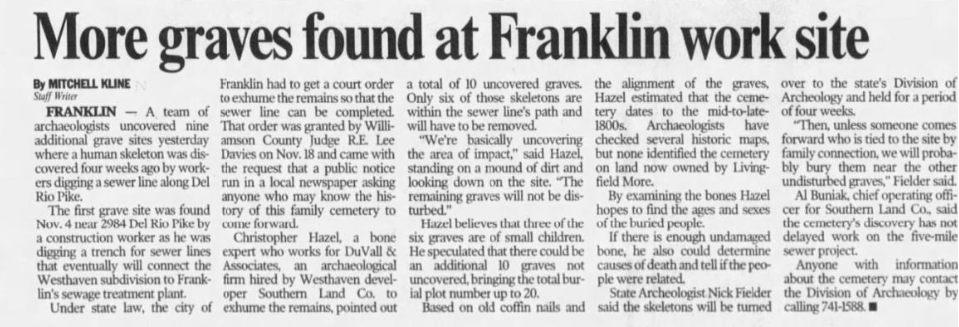
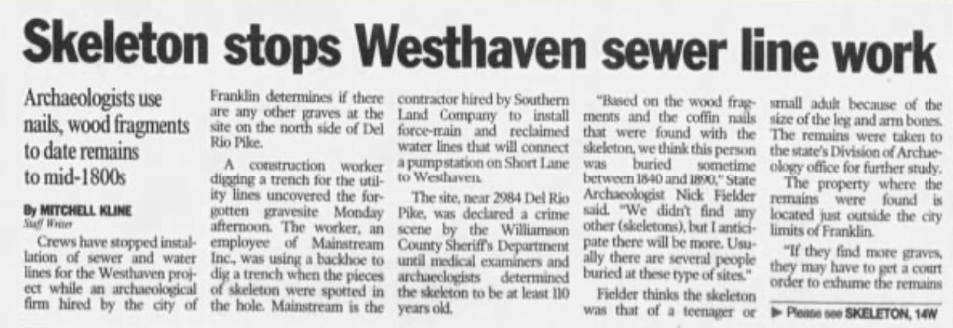

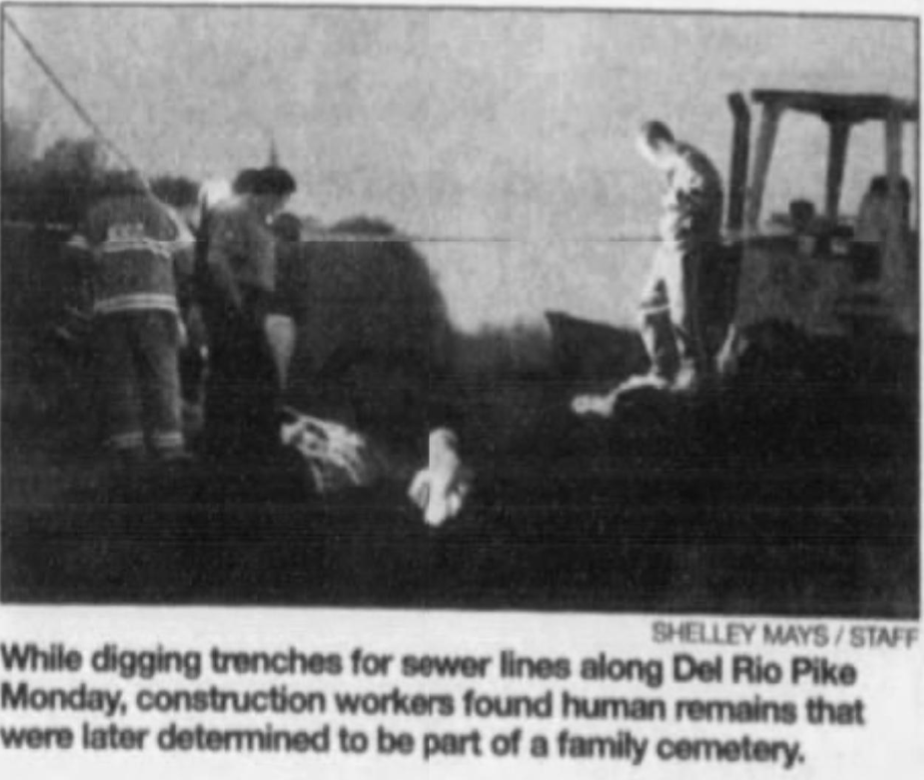
As you can read within the included newspaper clippings, many people took part in the investigation of the remains that were found. At first, the burial was thought to even be a possible murder. After finding out there was not only one burial, but several, and that they were burials of the enslaved, why didn’t the city of Franklin take note of the location of this cemetery? Why isn’t there a protocol in place of documenting these burials once discovered, setting perimeters of found cemeteries and making certain they are treated well by developers, builders and city workers?

Going back to the beginning

The Maury Slave Cemetery is located within the Founders Pointe neighborhood. It’s easy to see why no correlation between the newly found burials and the cemetery within the neighborhood was made, as a heavy thicketed berm and barbed wire fence separate the back of the Maury Slave Cemetery, and the area where the burials were found. The elevation of the Maury Slave Cemetery is quite a bit higher than Del Rio Pike, and seeing or walking through the thicketed divider would be impossible without equipment and time to remove the heavy brush and fence. Until recent years, Del Rio Pike has been a quiet road, and the entrances to Founders Pointe are on the opposite side of the neighborhood, as far away from Del Rio Pike as they can be. Another factor that most likely added to the confusion over the division of the cemetery would be in the fact that residents of the Founders Pointe neighborhood were never informed of the Maury Slave Cemetery being set aside within the neighborhood at all. Assuming it was an empty lot for ten years after residents bought the first homes in the community, the Maury Slave Cemetery finally received a marker and a memorial service given by neighbors in 2006. The cemetery would have remained an unexplained empty lot if residents of the neighborhood had not asked local historians to check into the reasoning behind the empty lot. It is doubtful that any residents of the Founders Pointe Community were aware of the 2002 burials unearthed, or that seven burials had been exhumed, or that there were any graves that ever existed outside of the perimeter of the neighborhood cemetery.
Abram Maury Plantation
The Maury Slave Cemetery is nestled within the Founders Pointe neighborhood, which was previously the Abram Maury Plantation.
Abram Maury brought his wife Martha, and much extended family to Tennessee even before it was a state, sometime around 1796. Abram and Martha Maury raised their family of nine children, seven of which grew to become adults, on the property that the Founders Pointe neighborhood was built on. Generations of their family continued to live at “Treelawn”, as their property was known, for over 150 years. The Maury’s family history is nothing less than remarkable, and woven into the very fiber of America. Abram Maury’s grandfather James ran a school in Virginia and taught three future presidents of the United States. Thomas Jefferson, James Madison and James Monroe were all students of his and shared lifelong admiration for Maury. Abram Maury was close with future President Andrew Jackson, so much so that letters between the two men proved Maury to be one of Jackson’s most ardent supporters, even suggesting to Jackson the idea that he should consider the presidency. Jackson’s closest confidante, aide de camp during the Indian wars and the War of 1812, Major John Reid, married Abram Maury’s oldest daughter Betsy. Matthew Maury, Abrams’ cousin who was mostly brought up at Treelawn, is considered to be one of the most accomplished Americans in the history of our country. His impact on not only our country, but also our world, is unmistakable. He is known widely as the “Father of modern Oceanography.” Unfortunately his support for the confederacy kept his accomplishments in the shadows. Our city of Franklin was, at one time, part of Abram Maury’s land, with him selling off town lots. He mapped and laid out the town of Franklin and is widely known as its founder. My husband Rob and I were so thrilled to be able to purchase a home in this gorgeous subdivision. Our home is directly across the street from the impeccably maintained and very historic Abram Maury Family Cemetery. Multiple generations of the Franklin Maury family are buried behind a gorgeous stone wall that encases tall obelisks and rows of headstones and footstones, with some of the oldest in the burial ground being several above ground crypts. Being an avid student of history, I dug in to studying all about the Maury, Reid and Harris residents of the burial ground, after settling into our new home. Each family member proved to have experienced lives only read about in books. The Maury’s were pioneers, innovators, city planners and legislators. I couldn’t get enough of learning about my new neighbors. Their connections to our Founding Fathers and their bravery in military service, exploration, academia; proved the Maury’s to be exemplary. One family member was Edgar Allen Poe’s West Point roommate, another served as the youngest Secretary of War in US history.
The town of Franklin has a storied past, having suffered through Federal occupation during most of the civil war, a difficult reconstruction and a battle that was so horrendous, the townspeople did all they could to try and forget. The bloodiest battle of the civil war, the Battle of Franklin, was fought close to downtown with many homes and other buildings greatly affected and later utilized as field hospitals. There were 10,000
casualties lying on the Franklin battlefield at the battle’s conclusion, and the burial and care of the dead from both sides of the affair became the paramount interest of residents of our sleepy little town. Witnesses described the aftermath as “the night when the devil took full possession of the earth.” More than one survivor of the battle described the streets of Franklin filled with a stream of blood afterwards. Despite damage done as a result of this assault, the town recovered, thrived even. A population boom started in the early nineties and Franklin experienced another more recently. The growth of Franklin most likely surpassed anything Abram and Martha Maury could’ve ever imagined.
As much as I loved learning the history of the Maury family, I couldn’t help but think of those they enslaved. Words cannot express the sadness I feel for those that have not only struggled and were so mistreated in their lives as an enslaved person. It’s even more of an atrocity when one contemplates the abuse they suffered in their life, combined with the abuse they’ve suffered after their death in the desecration of their burial sites. It’s almost as if these enslaved persons were twice enslaved.
Voices from the grave
When building homes back in 1996, developers set aside the land where the cemetery for the enslaved is located based on documentation provided in the Williamson County archives. At one time, a huge wild cherry tree grew in the center of the burials, serving as a sort of marker. Years ago, that tree was taken down by lightning. However, during a recent visit to the cemetery, of note were stones which still remain that may have served as markers for the African American slaves buried there. Also of importance was the existence of periwinkle growing in a shaded area under large bushes which served as a sort of buffer to nearby homes. Periwinkle is known to be used by African-Americans to identify where their loved ones are buried. Even against all odds, that periwinkle gives a voice to those who are buried within the Maury Slave Cemetery. These individuals should be treated with respect, and for their burials and the burials of their loved ones acknowledged, documented, and marked as hallowed ground. Sitting alongside the road, just north of the fenced in Maury Slave Cemetery, where the thirteen burials likely remain, a huge plant resembling a yucca sits. The plant is called a Great Mullein, and was heavily connected to the African American slave community, and in fact a part of many gardens kept by the enslaved. Great Mullein was used in a tea or poultice as an anti-inflammatory and helped greatly with respiratory illness.
George Washington Carver describing Great Mullein:
“I wish to say mullein is one of the oldest of our medicinal plants and is a noted remedy for all kinds of coughs and colds, rheumatic troubles, stopping of blood, asthmatic affections, and all manner of things that human ills are heir to. It is of unusual value along that line, one of the best known of household remedies. The flowers are especially valuable in aggravated cases of earaches”
The fact that Great Mullein stood out to me immediately when I visited the area where the thirteen burials remain is no accident. Before this visit, I didn’t even know what this plant was or that it even existed. It was growing where workers building a development nearby have laid out cones, I suspect marking the longitude and latitude noted in the More Cemetery archaeological report. These columns cones were most likely set out as a result of my contacting anyone and everyone I could think of in advocating for the proper treatment of these enslaved people, who have already suffered assault in life, and over and over in death.
About the Maury Slave Cemetery
Maury Slave cemetery sits serenely nestled between houses within the picturesque landscape of our quiet little neighborhood here in Franklin, Tennessee. Behind the cemetery, lies Del Rio Pike, which was formerly a quiet farm road lined with farm fences and plantations, with breaks in between of hay and cotton fields, horses and cows. Looking at aerial views over the years, of note are the changes progress brought in the location of Del Rio Pike. At times purposely and other times because of natural circumstances, the road would move over a few feet: sometimes even greater distances. Even the name of the road changed over the years.
1986
The only indication that there was a cemetery for the enslaved within our neighborhood was a notation made by historian Lula Fain Major within the Burial Book kept in the archives of Williamson county, Tennessee. Former property owner W.L. Reese took Lula Fain Major to the site where the burials of the cemetery were located and told her that when his father purchased the farm around 1900, that he was approached by a black man with the last name Maury. This man took Mr. Reese’s father to the cemetery, pointing out its perimeters, and asked if Mr. Reese could please not plow over it. This former resident went on to describe how he had two wives and twenty-three children buried within the cemetery, all dying of typhoid years prior. In the early nineties, developers building what would become the Founders Pointe Community, set aside the land outlined within this burial book. As far as can be ascertained, no other survey exists or has been completed to indicate how many burials exist and their perimeters within this burial ground.
Matilda
One day, while reading an old newspaper, I found something that was completely shocking. The Maury’s had not only been enslavers, but had even placed an ad looking for one of those they enslaved after she escaped their imprisonment. Matilda was a wanted woman, and an ad placed in the newspaper by Abram’s son, A.P. Maury was proof of her enslavement.

My eyes were opened upon seeing this ad, desperately looking for Matilda. They weren’t looking for her because she was lost, because they loved her, or because someone had taken her and possibly harmed her. A.P. Maury was looking for Matilda so he could enslave her once again, and take away her freedom and life. Matilda was his property.
His property.
I prayed the moment I read about Matilda running away that she ran far and fast and that she had a wonderful existence with all of the freedoms every human being should enjoy for the remainder of her life. “Run Matilda! Run” I found myself saying as I cheered her on. How was slavery then any different than modern day trafficking?
Essex, Montague, Gabriel, Sena, Ann, Henry, Narcysa, Polly, Willis, Nelly, Emely, Squire, Old Sena, Jack, Aggy, Jim, Eliza, Aham, Margaret, Agnes, Thomas, Sally, George, Patsey, Susannah, Nancy, Jude, Davy, Mack, Paschal, Phoebe, Peter, Joshua, America, Billy, Fanny, Eliza 2, Alfred, Manah, Archer, Pinckney, Ceiley, Annaleigh, Anderson, Leigh
I found these names attached to the will of Abram Maury’s granddaughter Elizabeth, who died at only 21 years old. Her will named each slave and ordered that they be divided five ways between family members. Because the Maury family came to Tennessee around 1800, they enslaved individuals for sixty-one plus years. Although Abram Maury passed away in 1825, for the next thirty-six plus years members of his family enslaved individuals inherited from Abram, and attained more as time went on. In 1860 the Abram Maury plantation had nine slave houses on the property, with the enslaved held by many different family members. The history of slavery on the Maury plantation is nothing less than abuse of the worst kind, taking a life and an individual’s personal freedom to better another.
There are many more enslaved individuals, but they remain nameless.
Answers
The below photos are from the report completed by archaeologists after the 2002 discovery of the burials adjacent to Del Rio Pike. The catalyst for my writing the state archaeologist was road work being done adjacent to Founders Pointe. This road work was close to the burials that were left after the 2002 discovery, and I wanted to insure they were not desecrated. I was given this report when I wrote to the Tennessee Department of Archaeology in September 2022. I grew more concerned and began to speak up and notify county and city officials when road work that was supposed to take a few weeks turned into almost a year to date. Here is a link to a pdf, as I have only inserted a few pages from the original report.
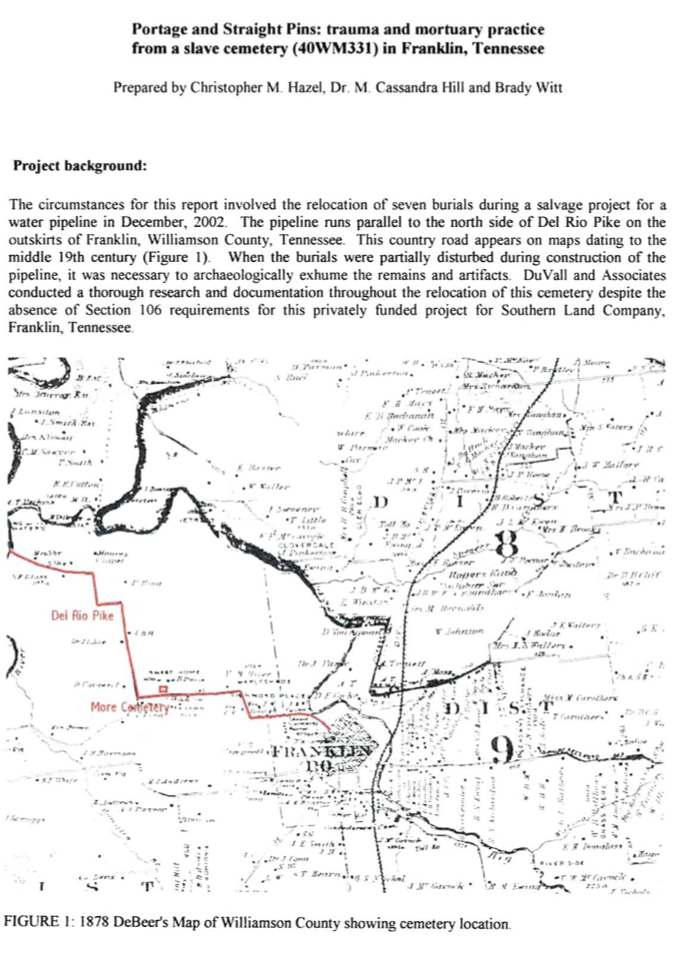
The Maury and “More Cemetery” were determined by archaeologists to most likely be the same cemetery, separated by neighborhood boundaries and Del Rio Pike.

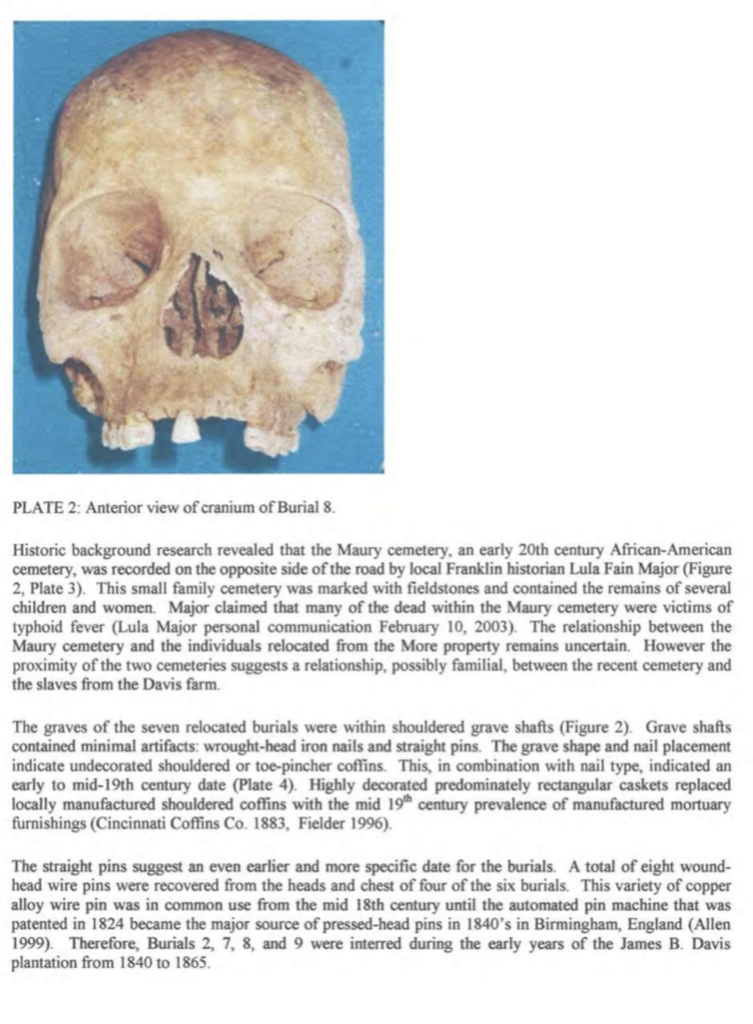
This photo shows the close proximity of the Maury Cemetery for the enslaved on Antebellum Lane and More Cemetery on Del Rio Pike:
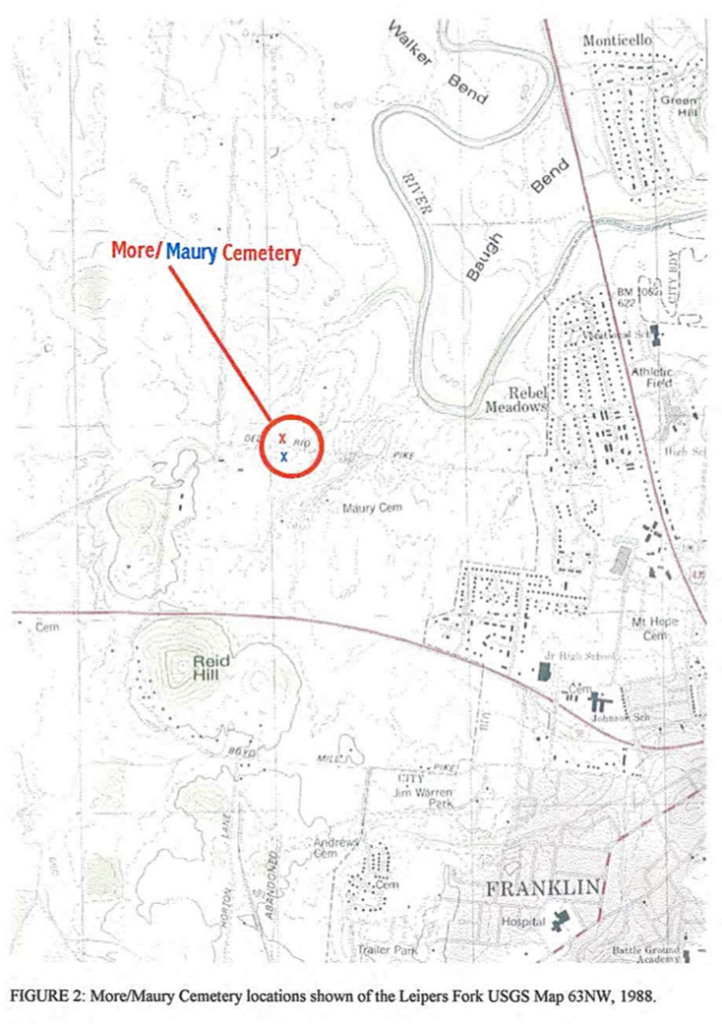
This is a view of the area where pipeline expansion lead to the discovery of burials of the enslaved, with the Maury Slave cemetery lying in the background to show the close proximity.
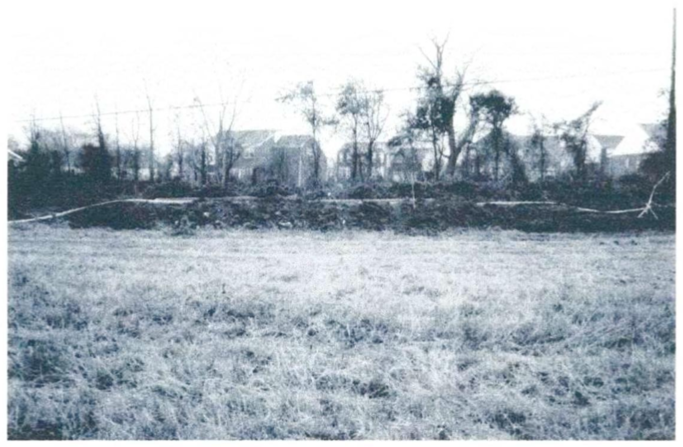


After compiling all of this information together, my opinion is that although the enslaved from other farms may be included within the “More Cemetery” documented by Tennessee State Archaeologists after the water line expansion in 2002, More Cemetery is in actuality an extension of the Maury Cemetery for the enslaved within the Founders Pointe subdivision.

Disturbing
While engaged in compiling all of this information and writing this article, I got some disturbing news. This information was an immediate call to action. On April 25th, 2023, I received word that a water line on Del Rio Pike will once again be expanded, necessitating the action of digging up that same water line where the burials were first discovered twenty years ago. A bridge adjacent to the burials will also be demolished and reconstructed. Existence of at least thirteen burials is part of the “More Cemetery” report completed in 2002. There may be many more burials in the area. I contacted the Founders Pointe Homeowners Association, City Alderman, City Administrators for the City of Franklin, Water Department, Street Department, and even the Mayor for help in advocating for these individuals and in the prevention of the desecration of their gravesites.

Advocacy
After going back and forth with different authorities from the city, one engineer set an appointment to meet me at the Maury Slave Cemetery, so I could explain the details of this dilemma and show him the closeness of the site where the burials were discovered in 2002, and the correlation in proximity to the existing marked burials located within the Founders Pointe subdivision. I got all of my information and compiled it into a couple of storyboards, to make it not only easier to understand, but also to revisit and confirm facts. I contacted several representatives from local preservation and historic organizations to come by simultaneously to this meeting with the city representative and check out the site, look at my storyboards, and hopefully help me in advocating for these forgotten burials.
On May 10th, 2023, our meeting took place with overwhelming results. Working on the story boards up until the moment I left home, I didn’t have time to prepare myself for the wonderful gathering of neighbors and advocates that showed up at the Maury Slave Cemetery. My wonderful husband set up a table and my daughter put out the storyboard, while I began to thank everyone for coming. Within moments a reporter appeared out of nowhere, and asked for an interview. I wasn’t prepared at all, and panic began to set in as I realized I wasn’t my best, as I’d invested all of my energy into the storyboards. While the reporter placed a mic at my collar and a mic pac in my back jeans pocket, I reminded myself of that first skeleton of the child backhoe operators uncovered back in 2002. I thought of Matilda and that horrific runaway slave ad, the nine slave houses that once existed close by where we stood and the multitudes of slaves that were born and died laboring all of their lives. This wasn’t about me, I was acting as their representative. I didn’t call the reporter, but I did my best to make the most of this opportunity to further fight for those buried in the forgotten cemetery under and around Del Rio Pike.
The May 10th meeting was a productive one on so many levels, with many great strides made as a result. The city official I was initially meeting with was completely neglected, and most likely overwhelmed at the arrival of our local news. However, he did come over and while briefly viewing the storyboards, gave me a commitment that no work would be done where the lost burials are located, unless I was notified in advance. He even offered to have the engineer creating plans for a nearby bridge replacement to send me the plans so that I would know unequivocally that the work would not disturb the lost burials.
After the meeting, the Williamson County Historical Society offered to place a larger marker at the existing cemetery within our neighborhood. Many neighbors, community advocates, and friends stepped forward to offer their assistance and encouragement. Lots of work is left to be done; this is only the beginning.
A Great Meeting
On Monday, May 22, 2023 city of Franklin Mayor Ken Moore set aside time to speak with me privately in his downtown office. Once again, I set up my trusty story boards and told him the story of the lost burials and their connection to the existing Maury Cemetery for the enslaved within my neighborhood. He was so kind and experienced the same level of empathy that almost every individual that learns of this travesty experiences. I left that meeting knowing I could contact Mayor Moore anytime and that he was not only an excellent advocate, but also a friend to me and this important cause.
Far from Over
Moving forward, I don’t want to let these burials fall to the wayside. It’s undoubtedly a terrible oversight that they somehow became a part of the landscape, lying under Del Rio Pike and within the easement and hay field across the street. Recent ground-penetrating-radar by the Tennessee Department of Transportation states that with very little investigation, they noted three burials. I suspect because of the many generations of enslaved individuals that resided on not only the Maury, but also the Davis plantation which borders it many more burials likely exist.
So my goals moving forward are:
First, in documenting the rest of the Maury and neighboring plantations’ entire sixty year plus history of enslaving individuals. Knowledge is power.
Second, to identify a property owner of the land connected to the easement area that might have more enslaved individuals buried. This area was where the neighboring plantation stood previously.
Third, I would like to obtain permission from the landowner and city to do a ground penetrating radar, as well as a LiDAR. LiDAR used light and aerial photography together to identify depressions and is very useful in finding lost gravesites. Getting both surveys done would undoubtedly give us more information as to the cemetery’s perimeter and number of burials.
Fourth, I would like any burials within the city owned easements or under Del Rio Pike to eventually be moved out of the way, so they are out of danger.
Fifth, I would like to raise money to have a fence and a marker placed for these enslaved persons, as they are very important and have a history that offers so much in the way of educating others about the history of slavery in our area of the world.
I will continue to seek advocacy and support from anyone that is willing to help to protect these burials and accomplish the goals set forth above. Proposals to city and county government need to be written and presented to our local authorities for the protection of all cemeteries.
Since I began advocating for these lost burials, I’ve had several people state that there are burials everywhere, we can’t set them all aside. However, these burials on Del Rio Pike are known, as they were unearthed by workers who had no idea of their existence. We know they are there. We know they have suffered a huge injustice with a road constructed on top of them, utilities placed all around them and some of their people exhumed, yet never returned.
We know who these people were, and how difficult life was for them. We know they were enslaved.
We know their story.
We know they are still suffering injustice.
And if we know better, we should do better …

Thanks for reading ... Kimberly
For more on Kimberly, please visit the About page on this website

